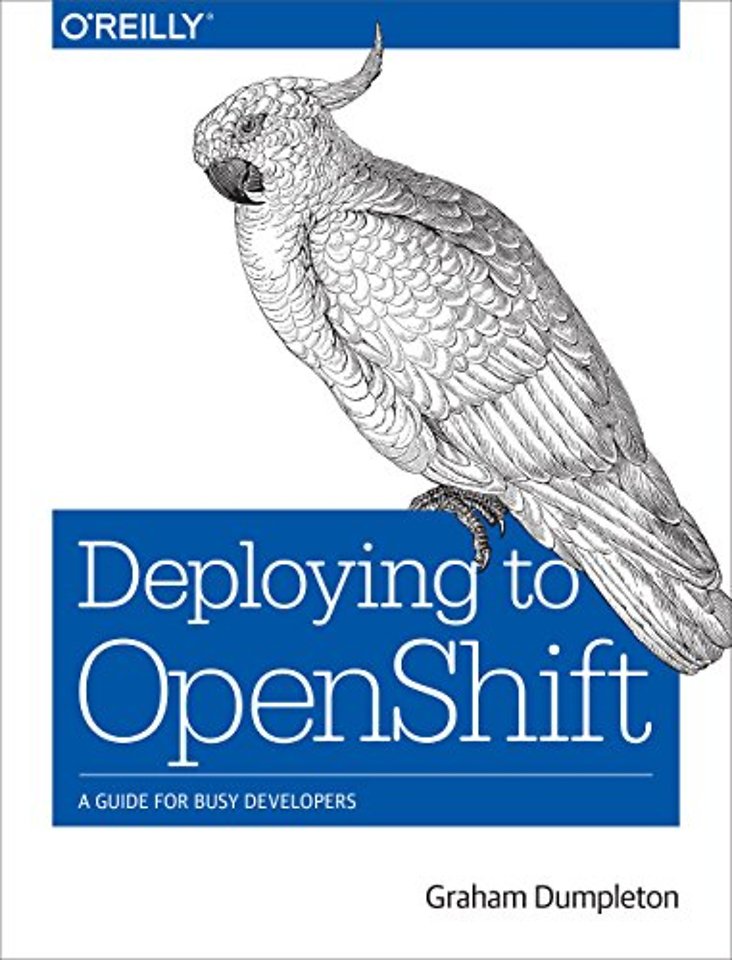Deploying to OpenShift
A Guide for Busy Developers
Paperback Engels 2018 1e druk 9781491957165Samenvatting
Get an in-depth tour of OpenShift, the container-based software deployment and management platform from Red Hat that provides a secure multi-tenant environment for the enterprise. This practical guide describes in detail how OpenShift, building on Kubernetes, enables you to automate the way you create, ship, and run applications in a containerized environment.
Author Graham Dumpleton provides the knowledge you need to make the best use of the OpenShift container platform to deploy not only your cloud-native applications, but also more traditional stateful applications. Developers and administrators will learn how to run, access, and manage containers in OpenShift, including how to orchestrate them at scale.
- Build application container images from source and deploy them
- Implement and extend application image builders
- Use incremental and chained builds to accelerate build times
- Automate builds by using a webhook to link OpenShift to a Git repository
- Add configuration and secrets to the container as project resources
- Make an application visible outside the OpenShift cluster
- Manage persistent storage inside an OpenShift container
- Monitor application health and manage the application lifecycle
This book is a perfect follow-up to OpenShift for Developers: A Guide for Impatient Beginners
Specificaties
Lezersrecensies
Inhoudsopgave
Who Should Read This Book
Why I Wrote This Book
Online Resources
Conventions Used in This Book
O’Reilly Safari
How to Contact Us
Acknowledgments
1. The OpenShift Container Platform
The Role of Containers
Orchestrating at Scale
Containers as a Service
Platform as a Service
Deploying Your Application
2. Running an OpenShift Cluster
Using OpenShift Online
Installing OpenShift Origin
Launching Using Minishift
Running oc cluster up
Summary
3. Accessing the OpenShift Cluster
Using the Web Console
Using the Command Line
Using the OpenShift REST API
Summary
4. Adding Applications to a Project
The Role of a Project
Creating a Project
Adding a Collaborator
Deploying Applications
Deploying from the Catalog
Deploying an Image
Deploying a Set of Resources
Summary
5. Deploying Applications from Images
Deploying Your First Image
Scaling Up the Application
Runtime Configuration
Deleting the Application
Deploying Using the Web Console
Importing an Image
Pushing to the Registry
Images and Security
Summary
6. Building and Deploying from Source
The Source Build Strategy
Deploying from Source
Creating a Separate Build
Triggering a New Build
Building from a Local Source
Binary Input Builds
Testing the Container Image
Build and Runtime Configuration
Summary
7. Building an Image from a Dockerfile
The Docker Build Strategy
Security and Docker Builds
Creating the Build
Deploying the Image
Build and Runtime Configuration
Using an Inline Dockerfile
Summary
8. Understanding Source-to-Image Builders
The Source-to-Image Project
Building the Application Image
Assembling the Source Code
Creating an S2I Builder Image
Building the S2I Builder Image
Using the S2I Builder with OpenShift
Adding an S2I Builder to the Catalog
Summary
9. Customizing Source-to-Image Builds
Using Environment Variables
Overriding the Builder Scripts
Read-Only Code Repositories
Overriding the Runtime Image
Updating the Image Metadata
Summary
10. Using Incremental and Chained Builds
Faster Builds Using Caching
Using Incremental Builds
Saving Artifacts from a Build
Restoring the Build Artifacts
Enabling Incremental Builds
Using Chained Builds
Summary
11. Webhooks and Build Automation
Using a Hosted Git Repository
Accessing a Private Git Repository
Adding a Repository Webhook
Customized Build Triggers
Summary
12. Configuration and Secrets
Passing Environment Variables
Working with Configuration Files
Handling of Secret Information
Deleting Configuration and Secrets
Summary
13. Services, Networking, and Routing
Containers and Pods
Services and Endpoints
Connecting Between Projects
Creating External Routes
Using Secure Connections
Internal and External Ports
Exposing Non-HTTP Services
Local Port Forwarding
Summary
14. Working with Persistent Storage
Types of Persistent Storage
Claiming a Persistent Volume
Unmounting a Persistent Volume
Reusing a Persistent Volume Claim
Sharing Between Applications
Sharing Between Containers
Deleting a Persistent Volume
Copying Data to a Volume
Summary
15. Resource Quotas and Limits
What Is Managed by Quotas
Quotas versus Limit Ranges
Requests Versus Limits
Resource Requirements
Overriding Build Resources
Summary
16. Monitoring Application Health
The Role of a Readiness Probe
The Role of a Liveness Probe
Using an HTTP Request
Using a Container Command
Using a Socket Connection
Probe Frequency and Timeouts
Summary
17. Application Lifecycle Management
Deployment Strategies
Rolling Deployment
Recreate Deployment
Custom Deployments
Container Runtime Hooks
Init Containers
Summary
18. Logging, Monitoring, and Debugging
Viewing the Build Logs
Viewing Application Logs
Monitoring Resource Objects
Monitoring System Events
Viewing Container Metrics
Running an Interactive Shell
Debugging Startup Failures
Summary
Afterword
What Was Covered
Final Words
Index
Anderen die dit boek kochten, kochten ook
Rubrieken
- advisering
- algemeen management
- coaching en trainen
- communicatie en media
- economie
- financieel management
- inkoop en logistiek
- internet en social media
- it-management / ict
- juridisch
- leiderschap
- marketing
- mens en maatschappij
- non-profit
- ondernemen
- organisatiekunde
- personal finance
- personeelsmanagement
- persoonlijke effectiviteit
- projectmanagement
- psychologie
- reclame en verkoop
- strategisch management
- verandermanagement
- werk en loopbaan







